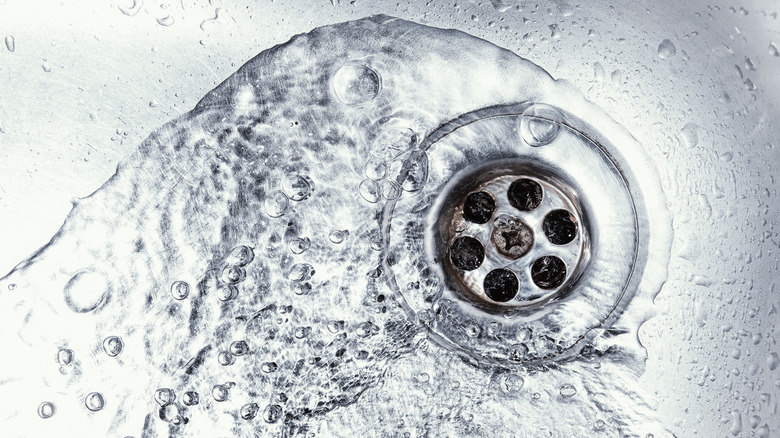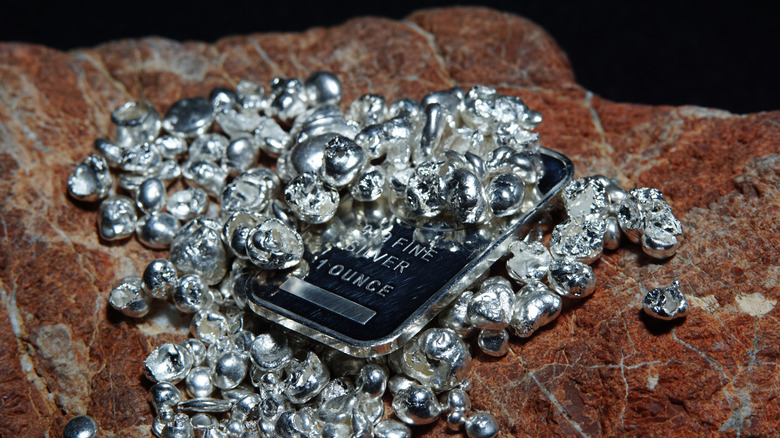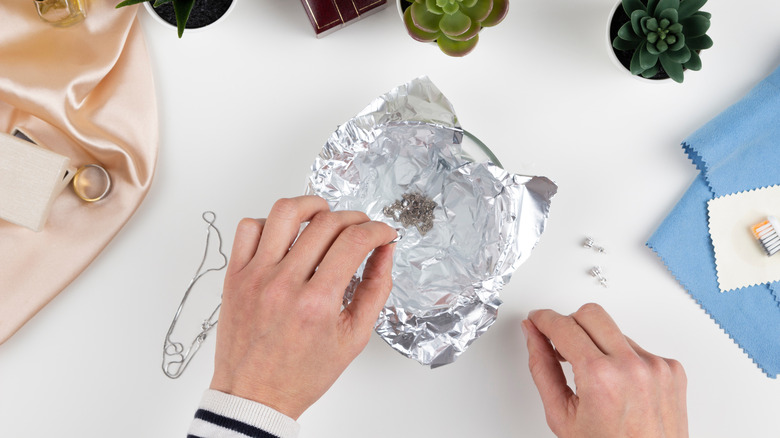Why You Should Never Dispose Of Silver Polish Down The Drain
A basic rule applies to anything one discards down the drain, and disposing silver polish that way is no exception. Nothing harmful should be sent down the sink or poured into storm sewers, and silver polish fits the definition of harmful household waste. Non-abrasive commercial silver polishes are non-existent, in the opinion of Jeffrey Herman Silver Restoration & Conservation. Therefore, putting the corrosive cleaner down your drain might very well damage the pipes, particularly older ones, according to Advanced Purification Engineering Corp. Doing so might generate a chemical reaction that ultimately will cause the plumbing to rust, leak, or clog. Furthermore, anecdotal evidence indicates that silver polishes can discolor the stainless steel of your sink and drain. Per Finishing.com, it is apt to leave dark gray stains or bleach marks in its wake when you dump or spill it, and even cleaning silver items in your sink can cause harm.
Silver polishes are toxic and classified as hazardous by the Environmental Protection Agency (EPA). They contain strong chemicals such as propylene glycol, ammonia, and sodium carbonate. Some of the polishing products even contain cyanide. This toxic cocktail is capable of damaging your septic system; it can contaminate the tank by disrupting its essential bacterial and could even potentially compromise your neighbors' water supply.
The problem with silver polish
Silver tarnishes and then requires polishing due to a chemical reaction with the hydrogen sulfide in the air. The process creates silver sulfide, resulting in the telltale discoloration of the metal. Polishing it removes the silver sulfide and restores the shine. However, the compound is an irritant to humans, and Chemistry Learner points out a two-fold error if you pour the silver polish down the drain. Not only are you carelessly discarding the polish itself, you are disposing hazardous silver sulfide along with it. In addition, the polish works by removing a layer of silver along with the tarnish, and ingesting silver itself or adding it to your home environment is also problematic.
Per Recycle More, even tossing silver polish in the garbage is not acceptable. By discarding of it improperly, its contents can potentially combine with other chemicals, with detrimental results in your household.
Safer alternatives
As is the case with disposing of any hazardous material, local, state, and national ordinances need to be followed when getting rid of silver polish. There are, however, other ways to safely discard empty containers or excess polish without resorting to organized collection.
Defer to applicable regulations instead of disposing silver polish down the kitchen sink or flushing it down the toilet. Your town may have community hazardous waste removal programs, collection events, or drop-off sites. Try to use up your entire supply, or consider giving the excess silver polish to a friend or neighbor. NAPA Recycling & Waste Services suggests wiping dry any remnants in a container. If no traces of polish remain, only then can the container be safely discarded in the trash. As with other hazardous materials, putting the substance in the garbage can pose a threat to the waste collectors.
A natural approach to cleaning silver is an environmentally-friendly alternative to chemical silver polishes; all you need is water, salt, baking soda, and a sheet of aluminum foil. The EPA instructs submerging the tarnished silver piece in a pan filled with boiling water and the aforementioned ingredients. Boil for three minutes, and repeat if needed. Other than producing a hint of rotten egg odor, there are no harmful effects. Remove the object and rinse, wipe, and polish. A small silver item can be cleaned using toothpaste and a cotton ball, too.


